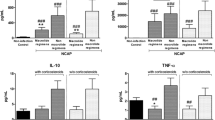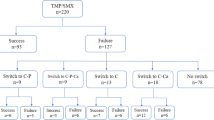Abstract
The aim of this study was to compare the evolution of systemic cytokine levels over time in patients with pneumococal pneumonia treated either with β-lactam monotherapy or with combination therapy (β-lactam plus fluoroquinolone). Prospective observational study of hospitalized non-immunocompromised adults with PP. Concentrations of IL-6, IL-8, IL-10, and TNF-α were determined on days 0, 1, 2, 3, 5, and 7. Patients on β-lactam monotherapy were compared with those receiving combination therapy. Fifty-two patients were enrolled in the study. Concentrations of IL-6, IL-8, and IL-10 decreased rapidly in the first days after admission, in accordance with the mean time to defervescence. High levels of IL-6 were found in patients with the worst outcomes, measured by the need for intensive care unit admission and mortality. No major differences in demographic or clinical characteristics or severity of disease were found between patients treated with β-lactam monotherapy and those treated with combination therapy. IL-6 levels fell more rapidly in patients with combination therapy in the first 48 h (p = 0.016). Our data suggest that systemic expression of IL-6 production in patients with PP correlates with prognosis. Initial combination antibiotic therapy produces a faster decrease in this cytokine in the first 48 h.


Similar content being viewed by others
References
Ardanuy C, Tubau F, Pallarés R et al (2009) Epidemiology of invasive pneumococcal disease among adult patients in Barcelona before and after pediatric 7-valent pneumococcal conjugate vaccine introduction 1997–2007. Clin Infect Dis 48:57–64
Barlett JG, Mundy LM (1995) Community-acquired pneumonia. N Engl J Med 333:1618–1624
Rosón B, Carratalà J, Dorca J et al (2001) Etiology, reasons for hospitalization, risk classes and outcomes of patients with community-acquired pneumonia hospitalized on the basis of conventional admission criteria. Clin Infect Dis 33:158–165
Feikin DR, Schuchat A, Kolczak M (2000) Mortality from invasive pneumococcal pneumonia in the era of antibiotic resistance, 1995–1997. Am J Public Health 90:223–229
Garcia-Vidal C, Fernández-Sabé N, Carratalà J et al (2008) Early mortality in patients with community-acquired pneumonia: causes and risk factors. Eur Respir J 32:733–739
Austrian R, Gold J (1964) Pneumococcal bacteremia with especial reference to bacteremic pneumococcal pneumonia. Ann Intern Med 60:759–770
Antunes G, Evans SA, Lordan JL et al (2002) Systemic cytokine levels in community-acquired pneumonia and their association with disease severity. Eur Respir J 20:990–995
Calbo E, Alsina M, Rodríguez-Carballeira M et al (2008) Systemic expression of cytokine production in patients with severe pneumococcal pneumonia: effects of treatment with a β-lactam versus a fluoroquinolone. Antimicrob Agents Chemother 52:2359–2402
Fernández-Serrano S, Dorca J, Coromines M et al (2003) Molecular inflammatory responses measured in blood of patients with severe community-acquired pneumonia. Clin Diagn Lab Immunol 10:813–820
Kellum JA, Kong L, Fink MP et al (2007) Understanding the inflammatory cytokine response in pneumonia and sepsis: results of the Genetic and Inflammatory Markers of Sepsis (GenIMS) study. Arch Intern Med 167:1655–1663
Menendez R, Martinez R, Reyes S et al (2009) Biomarkers improve mortality prediction by prognostic scales in community-acquired pneumonia. Thorax 64:587–591
Monton C, Torres A, El-Ebiary M et al (1999) Cytokine expression in severe pneumonia: a bronchoalveolar lavage study. Crit Care Med 27:1745–1753
Örtqvist A, Hedlund J, Wretlind B et al (1995) Diagnostic and prognostic value of Interleukin-6 and C-reactive protein in community-acquired pneumonia. Scand J Infect Dis 27:457–462
Xu F, Droemann D, Rupp J et al (2008) Modulation of the inflammatory response to Streptococcus pneumoniae in a model of acute lung tissue infection. Am J Respir Cell Mol Biol 39:522–529
Demartini G, Esposti D, Marthyn P et al (2004) Effect of multiple doses of clarithromycin and amoxicillin on IL-6, IFNgamma and IL-10 plasma levels in patients with community-acquired pneumonia. J Chemother 16:82–85
Choi J, Song M, Kim G et al (2003) Effect of moxifloxacin on production of proinflammatory cytokines from human peripheral blood mononuclear cells. Antimicrob Agents Chemother 47:3704–3707
Dalhoff A, ShalitI I (2003) Immunomodulatory effect of quinolones. Lancet Infect Dis 3:359–371
Clinical Laboratory Standard Institute (CLSI) (2009) Performance standards for antimicrobial susceptibility testing: 19th informational supplement. CLSI document M100-S18. Wayne, PA: CLSI
Clinical and Laboratory Standard Institute (CLSI) (2006) Methods for dilution antimicrobial susceptibility test for bacteria that growth aerobically; approved standard, 7th edn. CLSI documentM7-A6. CLSI, Wayne, PA
Fine MJ, Auble TE, Yealy DM et al (1997) A prediction rule to identify low-risk patients with community-acquired pneumonia. N Engl J Med 336:243–250
Waterer GW, Somes GW, Wunderink RG (2001) Monotherapy may be suboptimal for severe bacteremic pneumococcal pneumonia. Arch Intern Med 161:1837–1842
Martinez JA, Horcajada JP, Almela M et al (2003) Addition of a macrolide to a beta-lactam-based empirical antibiotic regimen is associated with lower in-hospital mortality for patients with bacteremic pneumococcal pneumonia. Clin Infect Dis 36:389–395
Baddour LM, Yu VL, Klugman KP et al (2004) Combination therapy lowers mortality among severely ill patients with pneumococcal pneumonia. Am J Respir Crit Care Med 170:440–444
Rodriguez A, Mendia A, Sirvent JM et al (2007) Combination antibiotic therapy improves survival in patients with community-acquired pneumonia and shock. Crit Care Med 35:1493–1498
Harbarth S, Garbino J, Pugin J et al (2005) Lack of effect of combination antibiotic therapy on mortality in patients with pneumococcal sepsis. Eur J Clin Microbiol Infect Dis 24:688–690
Aspa J, Rajas O, Rodriguez de Castro F et al (2006) Impact of initial antibiotic choice on mortality from pneumococcal pneumonia. Eur Respir J 27:1010–1019
Heumann D, Barras C, Severin A et al (1994) Gram-positive cell wall stimulates synthesis of tumor necrosis factor alpha and interleukin 6 by human monocytes. Infect Immun 62:2715–2721
Tomasz A, Saukkonen D (1989) The nature of cell wall derived inflammatory components of pneumococci. Pediatr Infect Dis J 8:902–903
Tuomanen E, Rich R, Zak O (1987) Induction of pulmonary inflammation by components of the pneumococcal cell surface. Am Rev Respir Dis 135:869–874
Tuomanen E, Vanholder R, De Paepe P et al (1996) Immunomodulating effects of antibiotics: literature review. Infection 24:275–291
Blaine T, Pollice P, Rosier R et al (1997) Modulation of the production of cytokines in titanium-stimulated human peripheral blood monocytes by pharmacological agents: the role of camp-mediated signaling mechanism. J Bone Jt Surg 79:1519–1528
Acknowledgements
This study was supported by research grants of Fundación Pi I Sunyer; FUCAP (Fundació Catalana de Pneumologia); REIPI RD06/0008 from the Ministerio de Sanidad y Consumo, Instituto de Salud Carlos III, Spanish Network for the Research in Infectious Diseases; by FIS (070864); and by Institut d’Investigació Biomèdica de Bellvitge (Dr. Garcia-Vidal).
Conflict of interest
None.
Author information
Authors and Affiliations
Corresponding author
Rights and permissions
About this article
Cite this article
Padrones, S., Garcia-Vidal, C., Fernández-Serrano, S. et al. Impact of antibiotic therapy on systemic cytokine expression in pneumococcal pneumonia. Eur J Clin Microbiol Infect Dis 29, 1243–1251 (2010). https://doi.org/10.1007/s10096-010-0993-0
Received:
Accepted:
Published:
Issue Date:
DOI: https://doi.org/10.1007/s10096-010-0993-0




